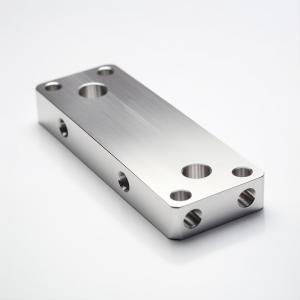
Add to Cart
CNC machining encompasses a wide array of machinery, all of which employ computer-controlled
machine tools to eliminate material from a workpiece.
The utilization of computer control imparts CNC machining with a remarkable advantage in terms
of speed, precision, and accuracy when compared to traditional machining methods.
Product Details
CNC milling encompasses a wide range of materials, primarily categorized into three major
groups: plastics, soft metals, and hard metals. These materials include aluminum, bronze,
copper, ceramics, plywood, steel, stone, wood, zinc, and numerous others.
The choice of material depends on ease of workability and desired properties, with those
offering favorable characteristics often being preferred in CNC milling applications.
| The Most Popular Materials | |
| Name | Characteristics |
| Aluminum 6061 | Good strength-to-weight ratio, excellent machinability, low hardness |
| Stainless Steel 304 | Excellent mechanical properties, resistant to corrosion & acid, relatively difficult to machine |
| Brass C360 | High ductility, excellent machinability, good corrosion resistance |
| ABS | Excellent impact resistance, good mechanical properties, susceptible to solvents |
| Nylon (PA6 & PA66) | Excellent mechanical properties, high toughness, poor moisture resistance |
| POM (Delrin) | High stiffness, excellent thermal & electrical properties, relatively brittle |



| Surface Finishes | ||
| Name | Applicable to | Machining marks |
| As machined | Metals, Plastics | Visible, light surface scratches |
| Smooth machining | ||
| Fine machining | Metals | Slightly visible |
| Polishing | Metals | Removed on primary surfaces |
| Bead blasting | Metals | Removed for non-cosmetic, removed on primary surfaces for cosmetic |
| Brushing | Metals | |
| Anodizing Type II | Aluminum | |
| Anodizing Type III | Aluminum | Visible under anodizing |
| Black oxide | Copper, Stainless steel, Alloy steel, Tool steel, Mild steel | Visible |
| Powder coating | Metals | Removed |
| Brushed + electropolishing | Stainless steel | Removed on Primary surfaces |
Specialist Industries
CNC machining is employed to fabricate products composed of glass, metal, plastic, wood,
and custom-designed components. Machinists utilize this process to create prototypes and items
for various industries, including aerospace, automotive, hardware startups, manufacturing, medical
devices, robotics, and others.

Company Profile


FAQ's
1. Cost of CNC Machining
The cost of CNC machining a part can vary based on several factors, including:
1. Material: The choice of material affects the cost, with some materials being more expensive
to machine due to tool wear and cutting speeds.
2. Complexity: Parts with complex features are more costly to machine compared to simpler
designs.
3. Tolerances: Tight dimensional tolerances increase machining costs, so it's essential to specify
them only when necessary.
4. Surface Finish: Achieving mirror finishes requires specialized tools and strategies, which can
add to the overall cost.
5. Quantity: Low-volume production tends to be more expensive per part than large-volume
production due to setup and programming costs.
2. What are your tolerances for machined parts?
Our tolerances for machined parts are typically within +0.005"/-0.005" for most metal geometries,
and within +/- 0.010" for plastics. However, tolerances may vary for larger parts, especially when
maintaining flatness over extensive sections post-heat treatment.
Regarding the finish requirements, an "As Milled" finish should have a minimum of 125 surface finish
for CNC parts.
For all fabricated parts, there is a dimensional tolerance of 0.010" and an angular tolerance of 1°.
Please note that tapped holes not explicitly indicated as features in the provided CAD model may be
machined to the specified diameters in that model.
Additionally, surface treatments like anodizing, bead blasting, iriditing, powder coating, etc.,
will only be applied if they have been paid for and explicitly acknowledged in advance.
3. What is the typical delivery time and quotation process?
Delivery time is determined based on the complexity of the parts. For low-complexity parts,
the lead time is typically 2-3 days. As the complexity of the parts increases, the lead time can
range from 2-5 days. High-complexity parts may require a lead time of 5-15 days.
Similarly, the quotation process varies depending on the complexity of your design. Quotes can
be provided in as little as 1 business day, or it may take 3 or more business days for more intricate
designs.
If you have a design that you would like our team to assess and provide a quote for, please don't
hesitate to contact us.